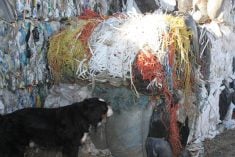The Canadian Cattlemen’s Association last week indicated it is willing to endorse the agricultural policy framework without fully knowing its detail or understanding its implications.
Stan Eby, CCA vice-president from Ontario, and Saskatchewan director Calvin Knoss told the House of Commons agriculture committee March 25 that negotiations have gone on long enough. Implementation is needed to ensure a disaster program is in effect for the livestock industry.
He said the details that are known appear to point in the right direction.
“We’re comfortable with the implementation date,” Eby told Canadian Alliance MP David Anderson. “Without the (April 1) implementation, there’s no coverage for livestock. We feel that we’ve been going around on this for a year and a half on a consultation basis …. It’s time to move on.”
Read Also

Message to provincial agriculture ministers: focus on international trade
International trade stakeholders said securing markets in the face of increasing protectionism should be the key priority for Canada’s agriculture ministers.
He said the CCA is concerned about possible trade implications of the new Net Income Stabilization Account program and it does not want production insurance to cover cattle.
Later, Manitoba Progressive Conservative MP Rick Borotsik wondered if the cattle industry had a clear understanding of what the new program would provide in benefits, how it is better than current programs and whether new programs would avoid trade challenges from the United States.
Were they even certain there would be no production insurance?
Eby said they did not have details.
Then are cattle producers prepared to endorse the program even without the details, asked the MP.
“I would say yes we are because we have some faith that these things have moved along,” replied the CCA vice-president.
Borotsik said he does not share Eby’s faith in the government.
Neither, apparently, does the CCA president and Saskatchewan rancher Neil Jahnke.
The day before the CCA went before the Commons committee to embrace the APF, Jahnke said in an interview the government had not convinced his organization that the new NISA would be trade neutral. This would put the cattle industry at risk of trade challenge if producers receive disaster money from a program that is partially challengeable.
“Whatever the government says about it being trade green, we think it is not and we want nothing to do with a program that makes us susceptible to American trade challenges,” Jahnke said March 24 after the CCA debated the issue at a closed annual meeting in Ottawa.
Eby attended the same conference before appearing on Parliament Hill with a different message.
Ottawa insists it will be able to report spending in the top 30 percent of production margin losses as amber, susceptible to challenge, but the bottom 70 percent of disaster coverage as green, protected from challenge.
Critics say there is no World Trade Organization rule that allows a program to be split in two for reporting purposes.
Last week, the government’s APF plan also received support from the Western Barley Growers Association.
Director Ed Armstrong told the agriculture committee March 27 the APF business risk management proposals are similar to Alberta’s Farm Income Disaster Program, which Alberta farmers like.
He split with most other farm groups in agreeing with government’s original proposal that the production margin to be used as a payment trigger should exclude such expenses as equipment repairs, building repairs and labour.
“We believe this will make the program more neutral as per type of farm operation and will remove basically all moral hazard issues,” he told MPs.
Many MPs noted this was a different message than they had heard from most farm groups.
It also conflicted with the Grain Growers of Canada, a national organization that counts the barley growers as a member but which has been arguing for a one-year delay in APF and a broader definition of expenses allowed in the production margin.














